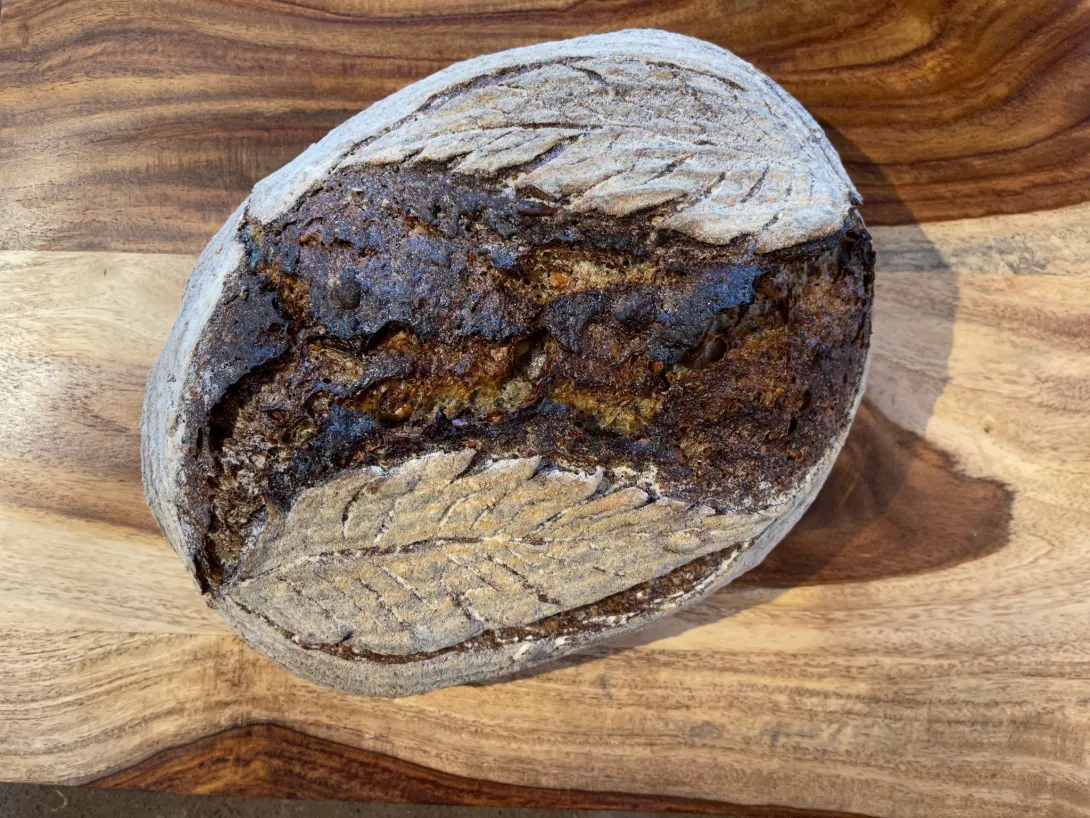
Based on my last bake which I felt didn’t have enough water, I wanted to see what would happen if I greatly increased the hydration for this bake. If you do not include the soaker water the hydration is 70%, but with the soaker water it is a crazy sounding 109% hydration. There was some spreading of the dough as it baked which I don’t like so I suspect the ideal hydration might be 5% less or just what the original recipe calls for. The original recipe is Hamelman’s Five Grain which is super popular here, but I wanted to play around with hydration and used a 100% hydration levain instead of his > 100% hydration.
This is my third time attempting a decorative leaf score on my bread and I think I’m starting to get the hang of it. Had I achieved a better oven spring on this loaf I think the leaves would have stood up more from the loaf. As well, between the end of steam baking and end of baking I lost some of the contrast between scored and unscored areas losing definition of the leaves. Although I brushed off excess rice flour it is obvious that I didn’t brush enough of it off and when handling the bread to get it out of the dutch oven much of the loose rice flour shifted into the scores. It’s too bad because the leaf scores actually looked decent this time. Something to work on to improve next time along with adjusting the hydration.
Levain 74ºF overnight
18 g starter 110 g water 110 g red fife
Dough mix saltolyse overnight
Bread flour 214 g
Spelt 71 g
Rye 36 g
Water 189 g (held back 20 g until next day added with levain)
Salt 8 g
Soaker overnight
34 g oatmeal, 0.68 g salt, 34 g black and white sesame seeds, 34 g poppyseeds, 34 g mix pumpkin and sunflower seeds 174 g boiling water
Overall 31% inclusions
1. Liquid Levain --- Make the final build 8-9 hours before the final mix and let stand in a covered container at about 74°F. Mix Levain and Soaker at the same time.
2. Soaker --- Pour the boiling water over the grain blend and salt, mix thoroughly, and cover with plastic to prevent evaporation. Make the soaker at the same time as the final build of the levain and let stand at room temperature. If grains that don't require a hot soaker are used (such as rye chops in lieu of the cracked rye listed here), a cold soaker will absorb less water, and therefore it's likely that slightly less water will be needed in the final dough.
3. Mixing --- Add all ingredients to the mixing bowl. In a spiral mixer, mix on first speed for 3 minutes, adjusting the hydration as necessary. Mix on second speed for 3 to 3 1/2 minutes. The dough should have a moderate gluten development. Desire dough temperature 76°F.
4. Bulk Fermentation --- 76ºF until 60% rise by aliquot jar
5. Folding --- the bulk fermentation should be 3.5 hours with 2-3 folds
6. Sharped and placed in banneton.
7. Final Fermentation --- After shaping leave on the counter at room temperature for 1 hour aliquot jar reached 75-80% rise, then place in fridge at 3ºC for 24 hour cold retard.
8. Baking --- With normal steam, 450°F for 20 mins then drop temperature to 420ºF and continue to bake lid on for 10 mins. Remove lid and bake for another 10 mins. Then remove bread from dutch oven and complete baking directly on the rack for another 10 mins.
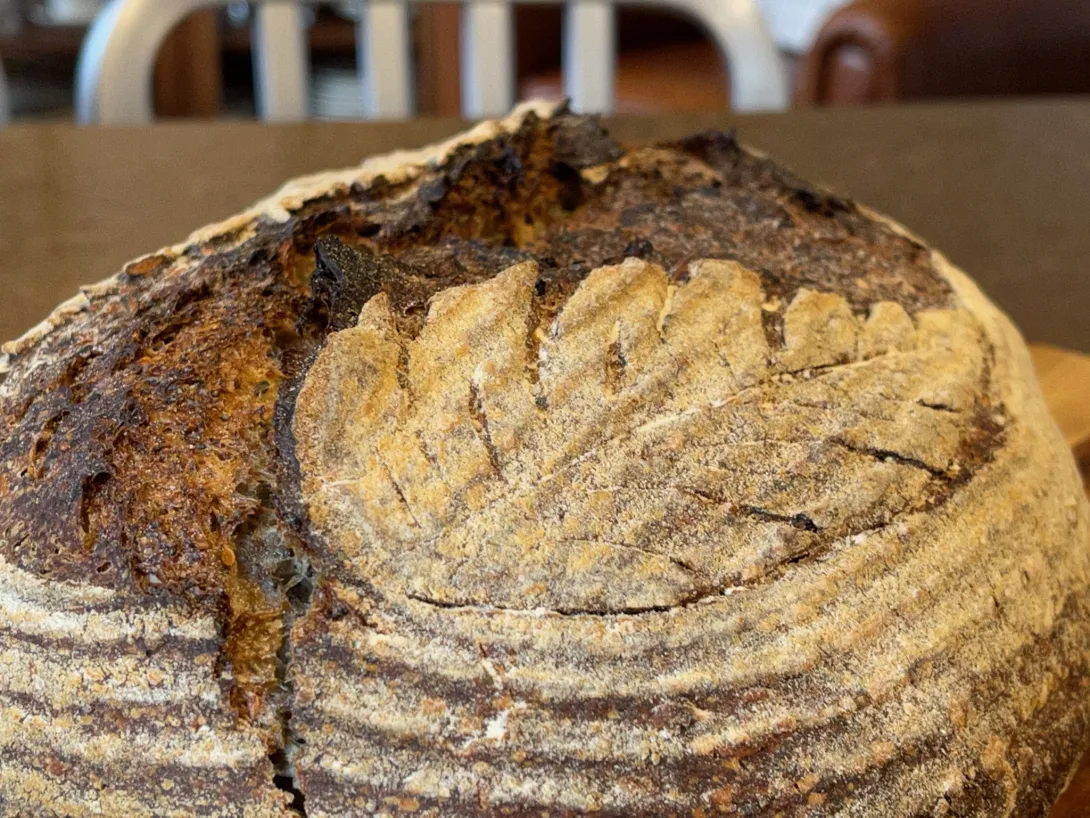
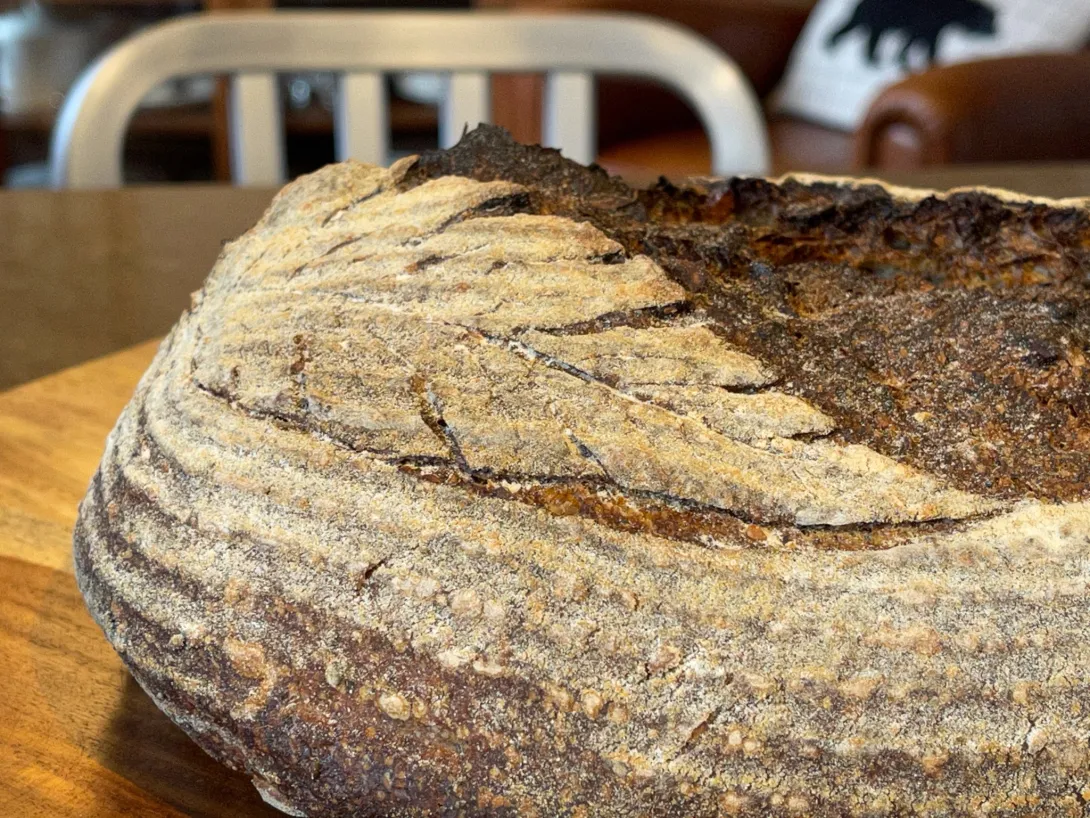
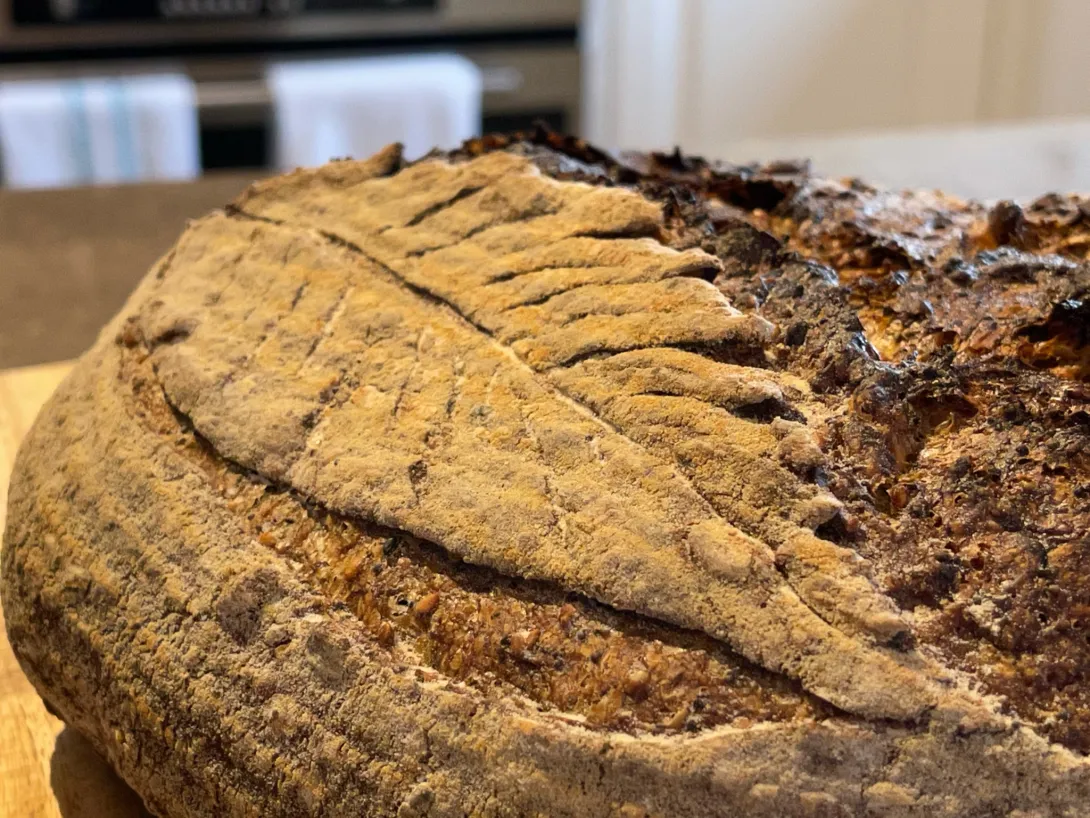
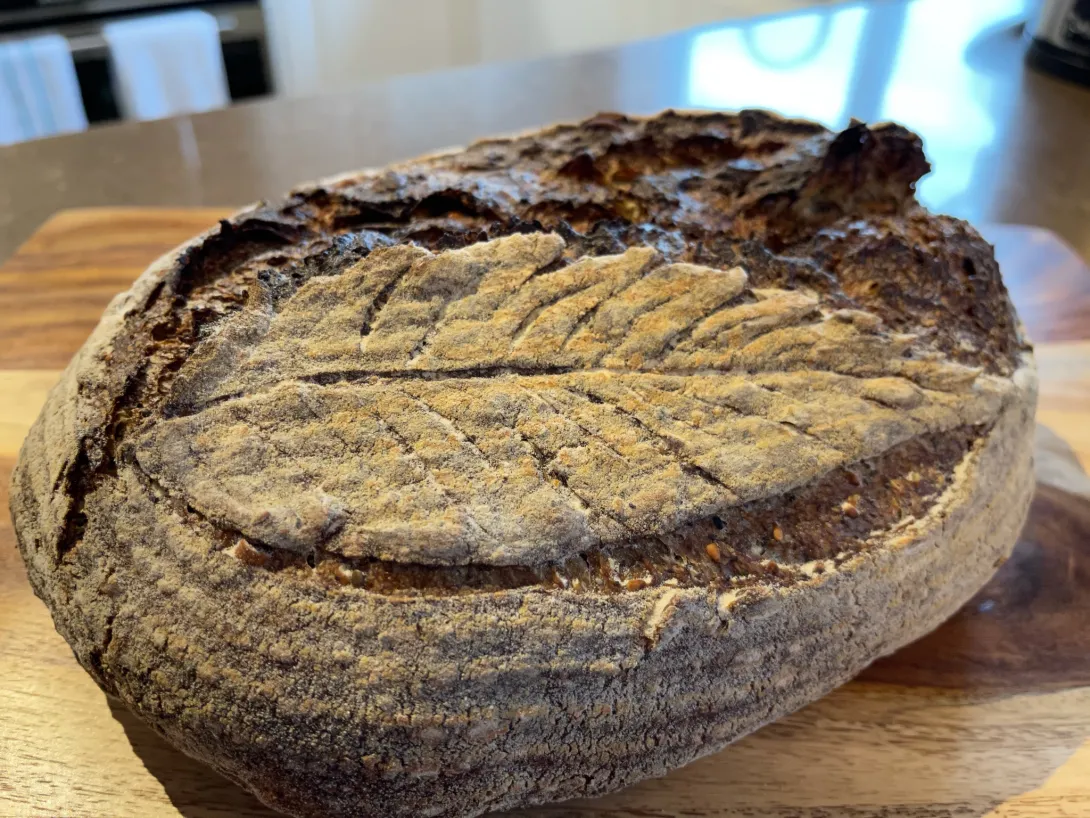
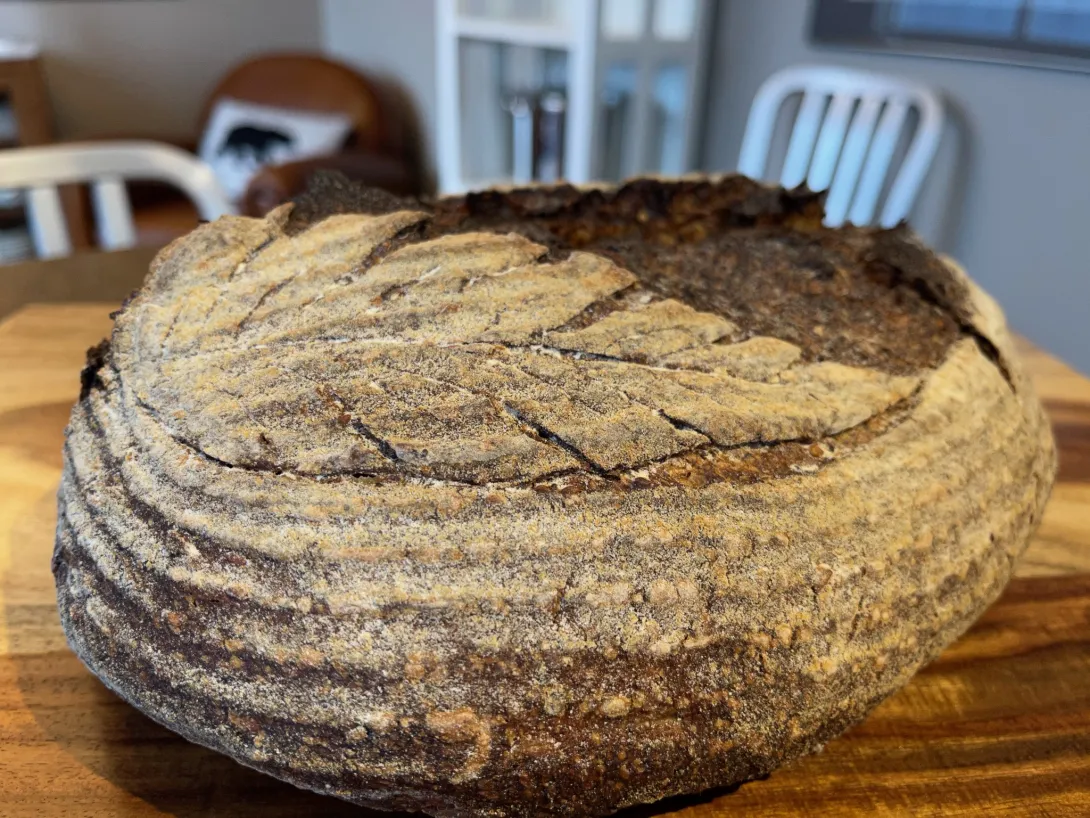
- Benito's Blog
- Log in or register to post comments
If so, he should be very pleased with what you've achieved here, Benny. That dark crust should contribute a lot of flavor to an already flavorful bread.
Paul
That’s good to know Paul, hopefully he wouldn’t be too disappointed that I’ve attempted to alter his recipe and turned out a flatter loaf LOL.
Benny
The additional hydration definitely had a positive effect on the crumb compared to my last bake with much less hydration (about 10% less absolute not relative). The crumb is moist and more custard like. The flavours of the grains and seeds is really hearty and delicious. The crumb has a nice gloss which I like to see. If I were able to achieve a better oven spring and profile with this hydration I would keep it the same, but for my current skills I think I’ll have to drop hydration and try again, maybe drop another 5%.
The crumb looks beautiful. I’m sure with a few adjustments you will get the oven rise you’re looking for. So what’s the purpose of mixing the salt in with the soaker?
Oh I thought that it might enhance the flavours of the inclusions, but in fact I accidentally added way too much and didn’t realize it until I noticed that the fermentation was going super slow. I then reviewed my notes and noticed my miscalculation of the salt adding 10% of the oatmeal rather than 2% LOL. I suppose with better fermentation with normal salt % and lowering the hydration I should be able to get better oven spring. I did like this crumb much more than the last one I baked where the hydration was way too low. I’ll drop it by 5% and try again.
Thanks for the comments Ian.
Benny
Looks like it would be very tasty. I'm sure with the adjustments you mention above the volume will improve. That said, it looks like a nice crumb and the grains you used should make this loaf unique and interesting.
Cheers,
Gavin.
Thank you Gavin, I’ll need to continue to adjust this recipe to get the bread I have in my mind’s eye.
Cheers
Benny
Very nice looking loaf and the crumb is perfect for me! I haven't seen your previous attempts with the leaf scoring, but I think you did great with this one. Clearly legible and can definitely see what you were going for with it.
Thanks for the comments Troy, much appreciated. I like the crumb too, I just have to adjust the hydration and hopefully get a better oven spring next time.
Benny
Looks good Benny. I'm sure it tastes great!
Frank, yes it is a good tasting loaf, very hearty. The crumb had a much better texture to me with the extra water. I’ll just have to make further refinements to get the loaf looking the right shape.
Happy Baking
Benny
Inspired by your impeccable bake, I tried my hand at this today. It's delicious but the crumb is quite tight, and I'm wondering why.
I followed the community bake recipe -- with a few tiny changes inspired by your revamp.
1. I used bread flour, whole spelt & whole wheat in the dough, with cracked rye, sunflower, flax and oats in the soaker.
2. I did not let the dough sit on the counter for an hour after shaping, but just popped it straight into the fridge.
3. I kept it in the fridge for 9 hours.
4. I baked it almost straight from the fridge, at about 460 with steam for 15 minutes, then at about 430 for half an hour more till done.
Q: do you have any thoughts on what might explain my tight crumb and lack of meaningful oven spring?
Thx.
Rob
Hi Rob, it would be helpful know more about other changes, such as bulk time and temperatures, number of folds, how and when you developed the gluten. Also photos of the finished loaf and the crumb would be helpful as well. There are so many possible variables that can affect the final loaf. Oh also your actual fridge temperature on the shelf that you did cold retard. The best way to measure that accurately is to place a glass of water on the shelf in the location your use for cold retarding your dough and a few hours later take the temperature of the water.
Benny
than you, that's for sure, and, of course, that may be my problem.
I can tell you this:
I started with a 100% rye sourdough starter that I have been using successfully for several months and, following the community bake proportions, mixed it with bread flour and water. I left the mix on the counter for 12 hours till it was super bubbly and shaggy and had essentially doubled in volume.
I mixed the dough by hand and bulk fermented it in a large bowl for 3 or 3.5 hours, with three folds over the first hour and 45 minutes. The dough seemed happy.
I baked 2 boules of maybe 750 g each. I have a pic that I snapped when I pulled them from the oven, but I can't figure out how to post it here (I don't have a crumb shot anyway, so I don't know how useful the photo would be).
Thanks so much for your thoughts.
Rob
To upload a photo
Then find your photo on your device following the prompts.
Photos are helpful to see the overall shape and rise of the loaf from the outside and a photo of the crumb can tell a lot about the fermentation and baking of the bread. It is hard to help without enough information to make a diagnosis.
OK how about profile shots which can give an idea of the rise or spread. Then sliced showing the crumb.
in my office, so that'll have to wait till later.
one other detail I forgot to mention: I didn't autolyze before mixing in the seeds (the dough seemed to need the moisture from the seed soak to fully come together)
Thanks, Benito, for playing bread doc for me.
Rob
a look at the architectural elevation of the bread. Thx for your thoughts.
Rob
OK so I see that the bread has a good profile, it is far from flat. I wonder if the density of the crumb is related to the hydration. I found the original formula to be a bit low in hydration for my flours and seed combination. What hydration did you use?
the community bake instructions on that ~ so 57 percent. As I mentioned, when I first added the water & levain, I found the dough too dry to autolyse.
I found the original recipe too low hydration for my flours and inclusions. You may want to increase the hydration somewhat that might help your crumb. My previous bake had a lower hydration and I found the crumb to be tighter than I wanted. That’s why I adjusted the hydration but think I went a bit too high with this one.
many thanks for your attention, Benito.
I've been making bread for about 9 months now -- and I've learned the most from reading you and a couple of other people on tfl.
I’m always happy to help when I can. I’ve also learned most of what I know from the good people on TFL.
Benny